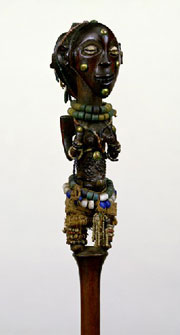Appropriating the Exotic:
Cross-Disciplinary Perspectives
A Symposium
at the Sainsbury Research Unit
for the Arts of Africa, Oceania and the Americas
University of East Anglia, Norwich, UK
8
– 9 October 2010
Venue Elizabeth Fry 01.08
This symposium provided the first comprehensive, cross-disciplinary study of the appropriation of the exotic in art and material culture as a cultural and material practice. The art-historical, anthropological and archaeological records abound with examples of objects, people, living creatures, materials and technologies that have been regarded as exotic, i.e. seen as imbued with special powers because of their external origins or foreign nature, and therefore have been subject to appropriation in a variety of ways in order to channel or control such powers. Examples range from the use of shells and amber in Palaeolithic personal ornamentation, to the importation of foreign materials and designs in early China, to Mande (West African) groups incising masks and other power objects with Islamic prayers.
While the term ‘appropriation’ acknowledges the rationale informing such practices, most research has focused on the political-economic circumstances that inform them. So far, little attention has been paid to appropriation as a cultural and material practice, and such practices have generally been considered misconceptions - ‘beliefs’ or ‘superstitions’. Likewise, the material and visual qualities that are handled, transformed or created in acts of appropriation have been considered arbitrary and therefore inconsequential for understanding appropriation.
Such specifics of material practices were a core focus of this symposium. It built on the growing attention in the social sciences and humanities to the way in which the material world is an active force in social life, and to the embodied nature of cultural practices. Speakers focused on the interrelatedness of cosmology, human agency, and material efficacy at given historical moments and situated these within political and economic contexts. They examined how and why Islamic prayers derived their efficacy when inscribed on polythetic power objects, why and how particular types of materials were used for personal ornamentation in Palaeolithic Africa and Europe, and what ends were pursued by high-status Chinese in adopting foreign materials and imagery.
The broad historical and geographical scope of the symposium particularly contributed to its innovative perspective. The commonalities between the material practices addressed, such as the transformation and display of foreign materials, the depiction and representation of self and other, the wrapping of objects and bodies, provided a unique opportunity to ascertain the efficacy of seemingly arbitrary materials, manipulations and transformations, and the way in which they enable, enhance or facilitate particular outcomes, while maintaining that these are historically situated and culturally specific.
As such, the symposium advanced our understanding of the embodied nature of culture and the efficacy of the material and visual world, while throwing significant and innovative light on a widespread cultural phenomenon that despite being extensively documented remains poorly understood.
Speakers:
(Click on speakers name to see the abstracts)
Colin Renfrew: Misappropriating the Exotic: The Lure of Diffusionism in Prehistoric Research.
Jessica Rawson: Beads, Bronze and Gold: Exotic Artifacts as Status Markers among Chinese Elites, 1000-650 BC.
Mary Helms: How Living Metal Can Nourish the Earth: Bronze Age Depositions in Cosmographical and Cosmological Perspective
Charlotte Townsend-Gault: The Internal Exotic: Indigenous Status in British Columbia
Debra Higgs Strickland: The Exotic in the Middle Ages: The Case of Ethiopians
Steven Hooper: From the Deep Sea and the Deep Forest: Material Embodiments of Exotic Power in Oceania
George Lau: Others as Exotics: Warfare and Alterity in the Ancient Andes
Fiona Sheales: Wrapping and Ratification: Asante Appropriations, Displays and Exchanges of Textiles in a Pre-colonial Diplomatic Context
Helen Anderson: The Exotic in Mind: Shells, Teeth and Amber in Paleolithic Africa and Europe
Bodil Birkebæk Olesen: When Mansa Musa went to Mecca: Power Objects, Islam, and Human Agency in the Mande World

Luba-Hemba Ceremonial Staff
(UEA 266) Zaire, Late 19th century
Carved wood figure of female ancestor embellished with
European trade beads, brass upholstery tacks,
imported cowrie shells and plant fibres
See the programme and abstracts of the symposium.
The symposium was organised by Fiona Sheales and Bodil Olesen.

